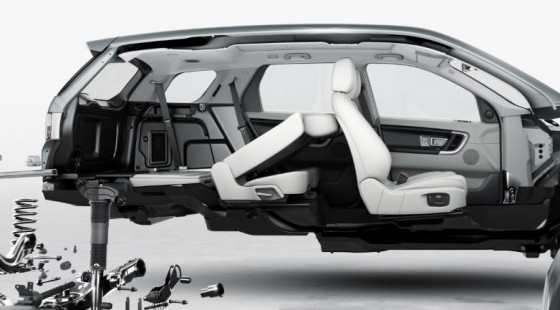From Catia to 3ds Max to V-ray to Nuke, the artists at Ink solved the challenge of putting a new Land Rover in the best possible light.
Land Rover recently introduced the Discovery Sport, a new entry into the competitive compact SUV market. The marketing team was tasked with trying to find a way to explain Discovery Sport’s technical and spatial details without an endless stream of figures. They solved their problem with help of a multi-vendor software workflow that moved from CAD to post-production video prep, step-by-step.

The resulting video created by production studio INK creates a fully CG break-apart exposé. The video (1:16) is posted at the end of this article. In the spot the camera swoops around the vehicle, each shot gently pulling apart the chassis of the vehicle to reveal the mechanical renders hidden underneath. It is both efficient and beautiful, if one thinks automotive engineering can be beautiful. It is definitely understandable.
“By combining technical understanding with beautiful imagery, we hoped to create an animation that remained visually engaging while clearly and accurately explaining the Discovery Sport’s packaging achievements,” says David Macey, INK creative director.
Having previously produced a series of animations exploring the Land Rover product line, INK has built up a strong understanding of the product. “At one end of the spectrum was the task of making sure that the practical design feats of everyday car components such as the glove box and USB ports were able to capture the attention they deserved,” adds Mike Haas, INK animation director. “At the other, we faced the challenge of communicating very technical elements such as the Discovery Sport’s rear suspension system as cleanly and accessibly as possible.”
Following the initial briefs, INK was supplied with Dassault Systèmes Catia CAD models, including elements such as the suspension system and engine. Engineering data, not artistic models, and that meant that work. “One of the biggest challenges was translating the CAD data over to our 3D pipeline in [Autodesk] 3ds Max,” says Macey. “This is because the data comes through as raw models with no materials, so each piece of geometry needs to be checked or remodeled, and have textures and shaders applied.”
Another problem was the CAD data only included car elements related to the mechanical components of the car. “We only receive hard surface data, so every soft surface in the car had to be remodeled,” says Macey. “That included the stitching in the seats, all the leather components, the car doors, the instrument panel—none of that comes through with the CAD data.”

Once the models were ready, the team created an animatic (storyboard + soundtrack) to choreograph the animation. The bursting apart and gradual reassembly of the various components needed to be achieved in such a way that the overall structure of the vehicle remained readable throughout the film.
“Maintaining the impact of the original explosion while ensuring that no shot became too visually chaotic was a fine balancing act,” says Haas. “We planned for that in the animatic stage, where we carefully choreographed the whole film.
“Once we had that ready we could work on the rendering – it usually took us two-three [Chaos Group] V-Ray render passes to get the final frame looking good. We also did lots of still frame renders while working on the animatic, so we could plan how we were going to comp the shot using [The Foundry] Nuke.”
IMHO, this approach makes for a unique vehicle spot—one that explores the technical specifications and underlying structure of the Discovery Sport without straying from the immediacy of visual impact. As INK’s Macey says, “The things we’re highlighting in the film might be everyday objects, but there’s a backstory to them – people have spent two-three years designing each of them, maybe longer. Our job is to bring that story to life with animation – to take something that might normally be taken for granted, and to make it something really interesting.”
Versatility & Packaging, Land Rover Discovery Sport from INK on Vimeo.





